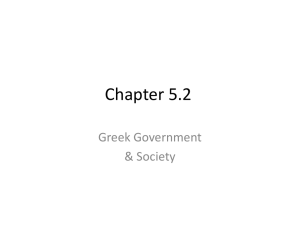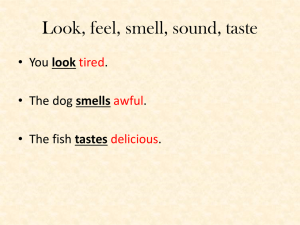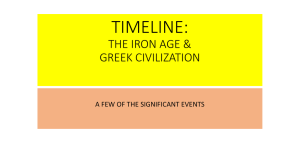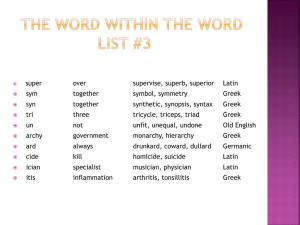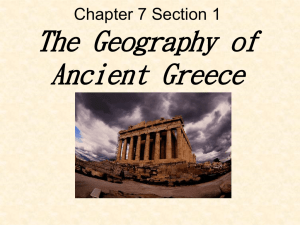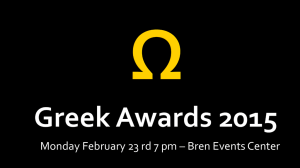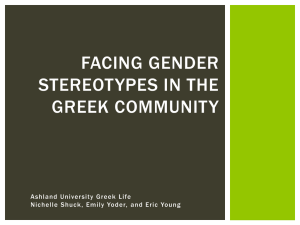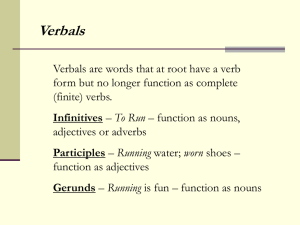Languages of the Eastern Mediterranean
advertisement
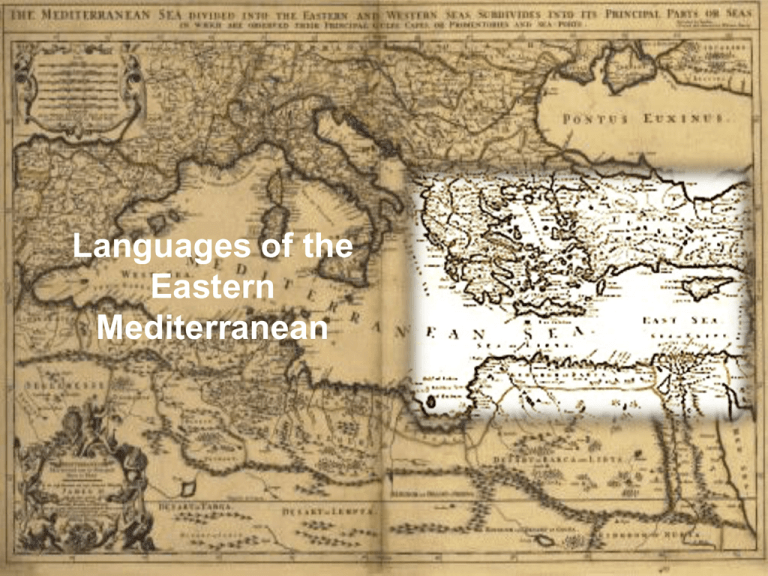
Languages of the Eastern Mediterranean Before it was the “Mediterranean”… • Despite the large number of peoples living on its Eastern shores and later expanding West, this Sea did not have a dedicated name from the start and for centuries to come. • For the ancient Egyptians, it was Uat-Ur (Wadj-Wer) = the “Great Green.” • In Biblical Hebrew, it is called (הים הגדולHaYam HaGadol) = the "Great Sea”, "The Sea”; also "Hinder Sea” (due to its location on the west coast of the Holy Land, and therefore behind a person facing East), "Western Sea”; the "Sea of the Philistines”, from the people occupying a large portion of its shores near the Israelites. • Ancient Greek historian Herodotus used the names of sub-parts of it while other Greek authors called it “the sea within Hercules’ Pillars” (=Gibraltar) or “our sea,” names echoed in later Latin “mare nostrum,” “mare internum,” and “mare insentinum” (=internal sea). Naming the “Mediterranean” • The name Mediterranean Sea is due to the Latin grammarian Gaius Julius Solinus (3rd c. CE), who coined the term Mare Mediterraneum meaning “the sea between two continents, sea situated in the middle of land, landlocked” (from medius “middle” + terra “land”). • However, the Romans themselves continued to call it Mare Nostrum ("Our Sea"), and occasionally Mare Internum. Map of Hecataeus (ca. 550-476 BCE) based on an older map by Anaximander (ca. 610-546 BCE) The Mediterranean in its languages • • • From classical Latin mediterrāneus, we get Italian mediterraneo (1282), Spanish mediterráneo (c1440), French méditerranéen (1569 in Middle French), as well as calques (semantic translations) in several languages, e.g., Albanian Deti Mesdhe, Armenian Միջերկրական ծով (Mitchergragan dzov - Midjerkrakan tsov), Berber Ilel Agraka, Bulgarian Средиземно Море, Catalan Mar Mediterrània, Corsican Mare Terraniu, Croatian Sredozemno more, Greek Μεσόγειος (Mesogeios), Modern Hebrew HaYam HaTikhon ( הַ יָּם הַ תָּיכֹוןfrom German Mittelmeer), Macedonian Средоземно Море, Maltese Baħar Mediterran, Occitan mar Mediterranèa, Romanian Marea Mediterană, Russian Средиземное море, Serbian Sredozemno more (Средоземно море), and Slovenian Sredozemsko morje. The Ottoman Turks called it Akdeniz, "the White Sea”, to distinguish it from the Black Sea to the North East – they used to designate the four cardinal directions by color: black for the North, red for the West, green or Yellow for the East and white for the South. The Turkish name is replicated in modern Arabic al-Baḥr al-Abyaḍ al-Mutawassiṭ ( البحر )األبيض المتوسط, "the White Middle Sea", while in Islamic and older Arabic literature, it was referenced as Baḥr al-Rūm ()بحر الروم, "the Roman/Byzantine Sea." A short (pre-)history of language contact in the Mediterranean • Perhaps because it was easily navigable and “friendlier” than the Ocean, as well as close to some of the earliest documented civilizations (Egyptian, Sumerian, Mycenean Greek), wherein important innovations such as writing also originated, the Mediterranean has been a center of intense language contact from the start, yielding some of the world’s earliest “global” languages. • Some linguists have proposed the idea of a pre-Indo-European Mediterranean substratum spoken throughout the European and African lands bordering the Mediterranean basin, whose traces are found principally in the names of places, plants, mountains and waterways. • With Proto-Greek (the first IE language to reach the Mediterranean) being documented by 2,500 BCE, that places any pre-IE substratum to a time before the 3rd millennium BCE. Language contact during historic times • Language families involved – Indo-European • • • • Greek Latin > Romance (Italian, French, Spanish,…) Albanian South Slavic (Croatian, Slovenian,…) – Afro-asiatic • Semitic (Hebrew, Arabic, Maltese…) • Berber (aka Tamazight, officially spoken in Algeria & Morocco, also found in Libya & Tunisia) – Turkic • Turkish Products of language contact: Koiné Greek and koiné languages • From Greek κοινή (διάλεκτος), "common dialect”; Koine Greek spread from its birthplace, the port of Piraeus near Athens, eastward and southward following the path of Alexander’s conquests. Products of language contact: Koiné Greek and koiné languages • Spoken approx. between 300 BCE and 300 CE, it is the language into which the Old Testament was translated and in which the New Testament (the Gospels) were originally written. Originally derided by grammarians as a debased form of Classical (Attic) Greek, it is also the form of Greek on which Modern Greek is based. • Since then, the term koiné in linguistics stands for a simplified version of a language that emerges as a product of contact between speakers of mutually intelligible varieties of that language and serves to mark their common sense of identity and belonging. Products of language contact: Sabir and Lingua Franca • Contrary to Koine Greek, which was first and foremost a written language of the administration, medieval Sabir (named after a Romance root meaning “to know”) was a spoken, non-codified language of communication between “Franks” (=Christians) and Arabs and later Turks during the crusades that was proliferated by sailors across the port cities of the Mediterranean starting in the 11th c. CE. • Historically the first to use it were the Genoese and Venetian trading colonies in the eastern Mediterranean after the year 1000. Later, its epicenter moved West to Algiers, where it was widely used by Christian slaves (up to 25,000), Barbary pirates and European outlaws alike. An example of Sabir is found in Molière's comedy, Le Bourgeois gentilhomme (“The Would-Be Noble”, 1670). Medieval trade routes Lingua Franca and lingua francas • Based mostly on Northern Italian languages and OccitanoRomance languages in the eastern Mediterranean at first, this original Lingua Franca, lisan al-afrang or lisan al-farang in Arabic, later came to have more Spanish and Portuguese elements, especially in North Africa, and has been hypothesized to be at the origin of later pidgin varieties emanating out of West Africa. • Sabir also borrowed from Turkish, French, Greek and Arabic and was used widely for commerce and diplomacy. • Today, the term lingua franca in linguistics denotes any language systematically used to make communication possible between people who do not share a mother tongue, often as a third language (cf. working language, vehicular language). The limits of contact: Infinitive avoidance in Balkan languages • A common feature of several Balkan languages, including some that border on the Mediterranean (Albanian, (Modern) Greek), is infinitive avoidance. This means that: “I want to go” is rendered as “I want that I-go” • The phenomenon of infinitive avoidance has been crucial for defining a Balkan Sprachbund or Balkan linguistic area. What’s in an infinitive? The ethnic identity of the Greeks • The lack of an infinitive in Modern Greek has been a particular source of chagrin for (modern-day) Greeks. This is because it was used by the Tyrolean scholar Jakob Philipp Fallmerayer in the early 1800’s to deny a link between Ancient and Modern Greek, and by implication between ancient and modern Greeks, whom he saw as a Slavic people. • At a time when Greeks were fighting for their independence from the Ottoman Empire with the support of Philhellenes from the West who sought to reinstitute Greece to its earlier glory, Fallmerayer found support for his theory of the Slavic origin of the Greeks in the modern language’s lack of an infinitive, which he castigated with the phrase “a language without infinitive is no better than a human body without a hand” (Fallmerayer 1845: 2.451-2). What’s in an infinitive? The ethnic identity of the Greeks • With the obsolescence of the infinitive from Modern Greek put down to influence from neighboring Bulgarian and Albanian (although the ancient language itself was veering toward analytic forms already, i.e. the influence may well have gone the other way), Greek scholars were relieved to hear of the putative survival of the infinitive in Pontic, a Greek dialect originally spoken on the southern shores of the Black Sea in modern-day Turkey, before Pontic Greeks were displaced to modern-day Northern Greece. • The story of the Greek infinitive is an opportune example of how linguistic phenomena can be “recruited” to prove larger ideological points, often with ambivalent results. … but also in Southern Italy and Malta • However, infinitive avoidance is not limited to the Balkan languages, It is also found in Italo-Albanian and Italo-Greek, as well as (more surprisingly) Romance dialects of Southern Italy (Calabrian, Salentinian). • While all of the above might be explained as a case of contagion from the Balkan mainland (during Byzantine times or even earlier), the same is not necessarily the case for Maltese, where infinitive avoidance also occurs. Now, if this were a result of language contact, that would be interesting, since Maltese is a Semitic language (like Arabic). Parallel developments in the same geolinguistic area • However, Arabic has its own pattern of infinitive avoidance (characterized by the absence of a subordinating conjunction that) which it has exported to a variety of unrelated neighboring languages, such as Persian (an IndoEuropean language) along with Islam. • A contact explanation is, thus not necessary to explain infinitive avoidance in Maltese. This is a feature that the language derives quite independently from its Semitic origins and need not have borrowed from its Romance neighbors – despite the reality of long-standing contact on the island, with Malta having been a Roman possession for centuries and then under Byzantine rule until the advent of the Arabs in the 9th century CE. The lesson to be drawn from all this? • “Infinitive avoidance… crosses quite a few linguistic boundaries and thereby connects languages from Romanian up North to Arabic in the South, from Calabrian in the West to Persian in the East. All seems perfect, because the languages form some kind of homogeneous geolinguistic agglomeration. Undeniably, there has been cultural and linguistic contact across the board for centuries. Nevertheless, diachronically speaking, we are not dealing with one phenomenon. Rather, we have to make allowances for two absolutely independent processes which accidentally happen to have similar results in neighboring languages.” (Stolz 2002: 272). Conclusion: Convergences among smaller, genetically defined subgroups • The present stage of inquiry suggests that, as far as language structure goes, there is no “Mediterranean linguistic area” in the same way we can speak of a Balkan linguistic area. Instead, what we find are some subareas which to a great extent reflect the genetic origins of the languages concerned. We find, for instance, a Romance as well as an Arabic area, admittedly with fringes, i.e. contact zones. • “This is certainly not surprising: a strong linguistic integration presupposes a high number of bilingual, or even multilingual, speakers, as was the case in Anglo-Norman England. After the fall of the Roman empire, such a situation never occurred on a comprehensive Mediterranean scale. Even the largely diffused Greek koiné [before that] was not able to form the basis of an East Mediterranean Sprachbund: it remained the written language of a cultivated but restricted minority.” (Ramat 2002: xiv)
